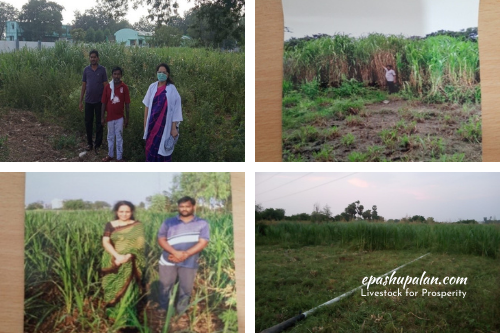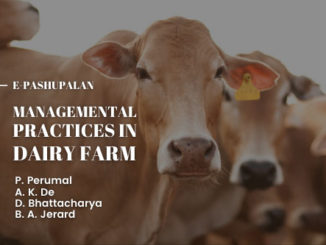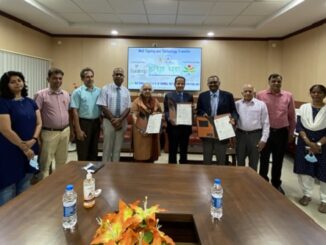Abstract
A frontline demonstration (FLD) was conducted during Covid 19 crisis to propagate an improved variety of fodder Super Napier where a total of 1Lakh Super Napier slips were distributed to ten beneficiaries belonging from BPL families of rural areas of Guntur district at the rate of 10,000 each. Before distribution demonstration programme was organized to educate the farmers on cultivation of Super Napier slips. The study was carried out from November 2019 to August 2021 and data on production of Super Napier was collected from the beneficiaries. In the present demonstration Super Napier yield 20 – 25 tons per acre. The average yield was 200 tons per acre per year with 8 harvest. The result revealed a significant increase in income @ 32, 000/ – per family/acre/annum for 3 harvest only by sale of slips @ 40 paise per slip 5 harvest are used for feeding of animals. Moreover, use of Super Napier fodder enhanced the confidence levels of poor farmers, weaker sections of society and rural women by generating income source for themselves by sale of slips and as source of fodder for livestock.
Key words: Super Napier, Rural women, livelihood, farmers
Introduction
Super Napier grass which is scientifically a cross of Napier grass (Pennisetum purpureum) and Pearl millet (Pennisetum glaucum). Packchong1 is the official name of Super Napier grass. It is originated in Thailand. It is one of the species of tropical grass which is perennial. Super Napier grass is high yielder one hectare can produce 500 tons of biomass. The grass is cut every 45 to 60 days. First harvest is at 60 days and subsequent harvest after every 45 days. In a year 8 harvests can be done. Livestock production is mainly constrained by lack of continuity in the supply of good quality feed, they mainly depend on either grazing or conserved forage in developing countries. Super Napier grass is one of the most popular grasses in the tropics and sub-tropics and has been the most promising and high yielding fodder with good adaptability that suppresses most tropical grasses. According to Woodard et al (2019) Super Napier grass is usually harvested at short intervals to feed at an early growth stage, because the nutritive value of the grass depends on harvesting intervals. Super Napier is an excellent feed for livestock. Chemical analysis reveal that it contains on fresh basis 1.21% crude protein, 10.12% crude fat, 10.2% NDF and 85.09% moisture (Jamaswat et al 2019). Calcium is found maximum in Napier grass (1.15%), crude protein of Napier grass 15.84%, (Shaon kumar., 2019).

Material and Methods
Super Napier is procured from NTR, CVSc, Gannavaram, 5000 slips are Cultivated in half acres land at Krishi Vignan Kendra, Sri Venkateswara Veterinary University, Lam, Guntur in the year 2017. After further propagation 3 acres of land is used for cultivation of Super Napier, for further sale and feeding of animals. A total of 1 Lakh Super Napier slips were distributed to ten beneficiaries belonging from BPL families of rural areas of Guntur district at the rate of 10,000 each. Before distribution demonstration programme was organized to educate the farmers on cultivation of Super Napier slips. The study was carried out from November 2019 to August 2021 and data on production of Super Napier was collected from the beneficiaries through semi structured interview schedule and the data was statistically analysed (Snedecor and Cochran, 1994).
Result and Discussion
Yield per acre
Perusal of table 1 revealed that majority of the beneficiaries (50%) observed the yield of 22 tons per acre. While at KVK, Guntur it is observed 25 tons per acre. The present finding is in agreement with Zac (2018) who reported an average yield 500 tons per hectare. In another study by Anindo et al (1994) reported that there is seasonal variation in productivity and nutritive value of Napier grass at Muguga. Nathuet al (2019) made a comparative Study on Biomass Yield, Morphology, Silage Quality of Hybrid Napier and Pakchong and their utilization in Bull Calves. Toor et al (2017) reported that Napier Bajra hybrid yield is between 42.9 to 53.3 kg/plot and check variety PBN233 gave yield 43.7 kgs. Wangchuk et al (2015) reported that Pakchong-1 seems to have no marked advantages over CO-3 and Giant for livestock feed, and feeding studies would verify this. Its higher stem DM yields may be advantageous for biogas production.
Sale of slips
In the present study, 50% of the beneficiaries got 32, 0000/- per annum by sale of slips only 3 harvest are used for sale of slips and 30% beneficiaries got 25, 000/- per annum by sale of slips. However, few respondents reported less than 25, 000/- per annum (Table 1). While at KVK, Guntur it is 25,000/-per annum by sale of slips. The present finding is in agreement with (Shantanu et al., 2018). Optimum Super Napier slips sale in this study is due to better managemental practices being followed in farm.

Economics
Income through sale of Super Napier slips @ 40 paise per slip 36, 000/- income was observed in majority of beneficiaries by sale of 90, 000 slips per year (Table 2). Potter et al. (1987) reported that inventory of feed resources for small holder farms in Kenya. Roy et al. (2016) reported that the existing Production and Marketing System of Fodder under Meherpur District, Bangladesh as Livelihood Activity.
The highest returns were mainly due to better sale of slips and accompanied by more survivability rate of fodder slips during the study period. The increased income over the cultivation of Super Napier fodder might be due to better productivity and sale of slips.
Conclusion
From the present study, it can be concluded that Super Napier slips gives better returns. A significant increase in subsidiary income (@ 32,000/- per family/acre/annum (for 3 harvest) was observed. It was also noticed that there was significant increase in consumption of Super Napier by livestock among the beneficiary families. The present study has achieved its goal by initiating income generating activity among the rural farmers and developed the entrepreneurial skills which helped in enhancing the self esteem of rural people.
Table 1: Production parameters of Super Napier fodder.
|
S. No. |
Parameters | Number of Beneficiaries n=10 | Percentage
|
SEM |
| 1. | Yeild per acres in Tons | |||
| 20 | 3 | 30 | ||
| 22 | 5 | 50 | 0.48 | |
| 25 | 2 | 20 | ||
| 2. | Sale of slips | |||
| 32,000/- | 5 | 50 | ||
| 25,000/- | 3 | 30 | 0.48 | |
| 20,000/- | 2 | 20 |
Table 2: Economics of Super Napier fodder
|
S.No. |
Expenditure |
Rs. |
| 1 | Purchase of 10,000 slips per acre @ 40 paise / farmer. | 4000/- |
| 2. | Net income per acre per annum by sale of slips for 3 harvest/ farmer. | 36, 000/- |
| 3 | Net profit per acre per annum by sale of slips for 3 harvest only/ farmer. | 32, 000/- + 302.81 |
References
- Anindo D. O., and Potter, H. l. (1994). Seasonal variation in productivity and nutritive vakue of Napier grass at Muguga. Kenya. E. Afrc. Agric. For. J. 59, 177 -185.
- Jamsawat, V., Langco, NC., Reyes, JL., Gaffud, DM., Pascua, EM and Seatung, C 2019. Study on Chemical composition of Super Napier grass Silage treated with Lactobacillus Buchneri and Lactobacilus Plantarum. Journal of Mycological Science 2(2):000109.
- Nathu, R. S., Dilruba Y., Farah, T., Md. Ruhul, A. Md. 2019. Comparative Study on Biomass Yield, Morphology, Silage Quality of Hybrid Napier and Pakchong and Their Utilization in Bull Calves. Journal of Agricultural Science and Technology 9(3):166-176
- Potter, H. L. 1987. Inventory of feed resources for small holder farms in Kenya. In proceedings of the 2nd Panesa workshop IDRC (International Development Research Centre) Nairobi, Kenya pp. 2 – 22.
- Roy, B. K., Sarker, N. R., Alam, M. K., and Huque, K. S. 2016. “Existing Production and Marketing System of Fodder under Meherpur District as Livelihood Activity.” Bang. J. Livest. Res 19 (1-2): 24-32.
- Shantanu, K. D., Gautam, U. S., Atar, S., Anand, S. and Anand, S. 2018. Empowering cattle keepers for on farm production and utilization of green fodder and planting materials: Hybrid Napier (Penisetum Purpuream) in Sitapur District of Uttar Pradesh. Journal of Extension Education Vol. 54, No. 2. (126 – 132)
- Shaon Kumar Das 2019. Qualitative Evaluation of Fodder Trees and Grasses in Hill Region. J Krishi Vigyan, 7 (2) : 276-279.
- Toor, A.K.*, Kumar, A. and Kapur R. 2017. Evaluation of napier bajra hybrids for yield and other parameters. International Journal of Genetics ISSN: 0975-2862 & E-ISSN: 0975-9158, Volume 9, Issue 7, 2017, pp.-287-290.
- Wangchuk, K., Rai K., Nirola, H., Thukten Dendup C and Mongar D (2015). Forage growth, yield, and quality responses of Napier hybrid grass cultivars to three cutting intervals in the Himalayan foothills. Trop Grasslands 3:142-150.
- Woodard, K. R., and Prine, G. M. 1991. “Forage Yield and Nutritive Value of Elephant Grass as Affected by Harvest Frequency and Genotype.” Agron. J. 83: 541-6.
- Zac, B. S. 2018. Super Napier planting guide. Agriculture monthly 28 February 2018.







nice ! good read .
stay awesome and keep blogging
http://www.pomeranianpuppies.uk
It is unfortunate that you don’t mention, how seed is required in a one hectare of Super Napier 20